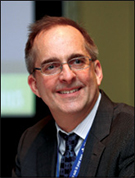Converting DICOM Images to 3-D Printed Models Critical to Progress
To fulfill the true potential of 3-D printing, radiologists will need to learn to render DICOM as 3-D printed models, according to one expert

The impact of 3-D printing is so significant that it may become the standard way that doctors “talk to their patients.” However, certain challenges must be overcome before the modality realizes its full potential in radiology and healthcare overall, said a presenter of an RSNA 2015 session.
“3-D printing is a completely disruptive technology in general and in medicine,” said Frank Rybicki, M.D., Ph.D., professor and chair of the Department of Radiology at the University of Ottawa Faculty of Medicine. “It will change the way that doctors do procedures. It will change the way we teach young physicians.”
3-D printing refers to the fabrication of graspable objects from digital models. 3-D printing itself depends on the advanced imaging modalities and protocols to generate source DICOM images amenable for printing. And while advanced visualization displays play a role in communicating information to referring clinicians, “there is an unmet need that radiologists need to fulfill to render DICOM images as 3-D printed models capable of providing both tactile feedback and tangible depth information of both anatomic and pathologic states,” Dr. Rybicki said.
“Radiologists are trained to make a diagnosis using ‘routine’ 2-D images such as CT and MRI,” Dr. Rybicki said. “Thus far, we don’t have evidence that 3-D printing changes diagnoses. We hope that the ability to diagnose from 3-D printing will be realized in the future.
“The next natural step in the progression of technology is 3-D printing. That is, taking the same DICOM images we use for 3-D visualization and generating 3-D printed models,” Dr. Rybicki said. “Until now, what radiologists have not been able to do is allow the referring physician—for example the surgeon—to plan the procedure ahead of time with a 3-D model that can be held in their hands,” Dr. Rybicki said. “Sometimes, the ‘referring’ physician is a radiologist doing an image-guided procedure. There is a large amount of evidence showing that this is now an essential part of patient care.”
Radiologists will need to learn the software to convert images to DICOM, Dr. Rybicki said.
It is essential that radiologists invest the time to learn the methods so that the printing of medical models from CT and MR images becomes integrated with radiology departments, he said.
Dr. Rybicki first began moderating didactic courses in 3-D printing at RSNA 2013. In 2014, participants were taught the software used to convert the image from a CT scan to a hand-held printed model for the first time. At the RSNA 2015 session, they did the same.
Reimbursement, Cost Remain Hurdles
There are a number of obstacles to more mainstream adoption of 3-D printing, including cost, training, materials, equipment, guidelines and the need for a consensus in terminology.
“If we’re going to get reimbursement, we need a single reporting standard for 3-D printing,” Dr. Rybicki said.
And reimbursement, he said, will be a major hurdle.
“All payors know that we need 3-D printing, and that it will eventually be reimbursed as the demand continues to swell,” he said. “This will happen as we accumulate more data, and then develop guidelines regarding appropriate utilization. While there are many pressures to contain costs, data is beginning to show that the generation of 3-D models is cost-effective for several applications, particularly when the model saves time in the operating room.”
Many vendors at RSNA 2015 introduced new 3-D printing software, hardware and new collaborations, he said. “This will drive down the costs over time.”